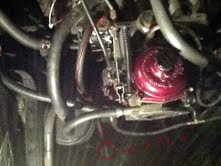Question
 intake manifold
intake manifold
I have a hose (half-inch black) coming off my intake manifold, on top and to the rear, it is just hanging there, has a hose nipple (maybe 3/16s). any idea where it goes. I am having a problem with engine, no power, cant get more than 3000 rpm's out of it. Any suggestions are welcome.
(sending pic)
AnswerHi Steve,
First check if there is any vacuum on the hose with the engine running. Most versions of the Spitfire used that straight vacuum to power the "anti-run-on valve" next to the charcoal canister.
An open vacuum hose will affect the way the engine runs. If that hose is a vacuum hose and it is open just plug it and then test drive the car to see if that is all the problem. If not, you need to start from scratch and run a full diagnostics. Any time we had a car running badly and no obvious problem is there (like a vacuum hose off) then we had to start from scratch.
First is a compression test. Pull all 4 plugs and remove the white wire/s off of the coil. Then hold the throttle open and spin the engine at least 5 or 6 revolutions on testing each cylinder. You need to see at least 130 PSI to 170 PSI on all 4 cylinders with little difference between each cylinder.
If it did not pass this test it is a waste of time continuing.
Second is Ignition, with the plugs still out connect each plug to it's wire and lay each plug on a metal part of the engine and reconnect the white wire/s.
Spin the engine and watch the plugs fire and the spark should be thick as a pensil lead and blue in color (not it bright sun light)
If they all look good put your thumb over #1 plug hole and have someone spin the engine over and watch the #1 plug spark which will make a "Click" sound and at the same time the compression will blow your thumb off of the plug hole with a "Pop" sound. The "Pop" sound should seem to be causing the "Click" of the spark. If it seems as though the two are not related like a "Click-Pop" or a "Pop-Click" then the timing is far out of range.
This is just a preliminary check to see that the timing is close enough to run, it does not mean that the timing is exact.
Check the timing anyway to be sure.
Now and only if everything above it correct can you look at fuel as a cause. First test of the fuel system is a fuel pressure test. Put a "T" in the fuel line at the carburetor and a fuel pressure gauge on the "T" (be sure to use clamps on every connection) Start the engine and you should see from 1.5 PSI to 3 PSI and no more nor less.
Then check to see that the float chamber vent hose is clear. (an easy test is to remove the hose and leave it off while testing)
Remove the top cover and inspect the diaphragm for holes and inspect the metering needle for damage.
It is difficult to check the float level without removing the carburetor but you can make a preliminary test. Put your face down close to the open carburetor and quick hard puff into the opening and quickly look at the jet. (the jet is the copper ring in the center and which the metering needle stuck into.) If the float level is close to correct you will see a small amount of fuel come up out of the jet just after you blew into the center toward the jet.
If all of this is correct take you fuel pressure gauge (usually the end reading of a vacuum gauge and connect the vacuum gauge to the intake vacuum and read intake vacuum and raise the RPM up high and watch the vacuum. At no time should it read lower then 5 in hg. (Sometimes it is necessary to run the hose out from under the hood and place the gauge under a wiper arm so you can see the gauge and drive that car up to the 3000 RPM you see on the road and watch the gauge. There is no driving condition that you can do on a normal engine to read lower then 5 in hg. This test is most important if this car has been stored for some time.
If you don't have a compression gauge and a vacuum gauge, they are not expensive and necessary to test any engine.
Let me know,
Howard
